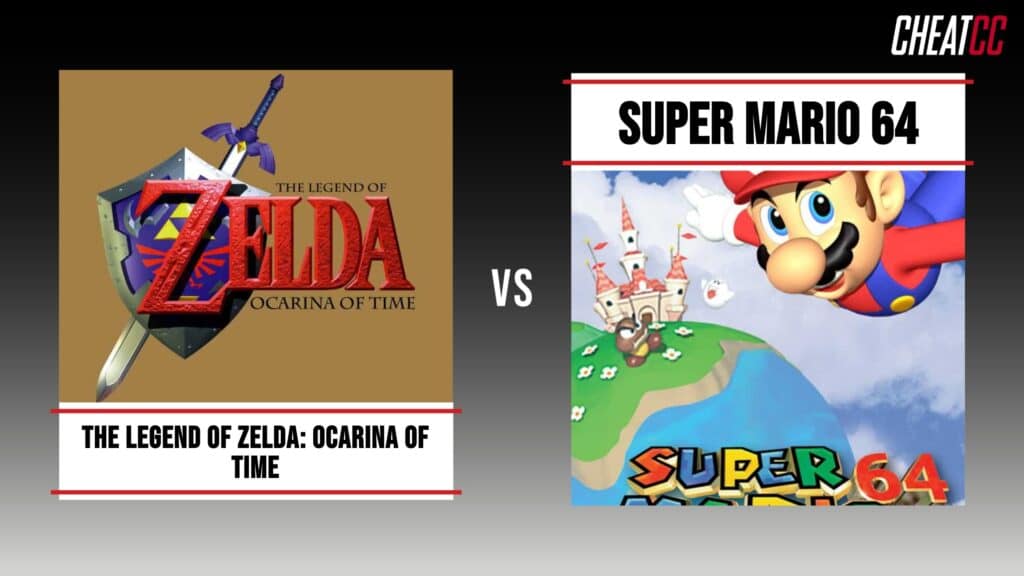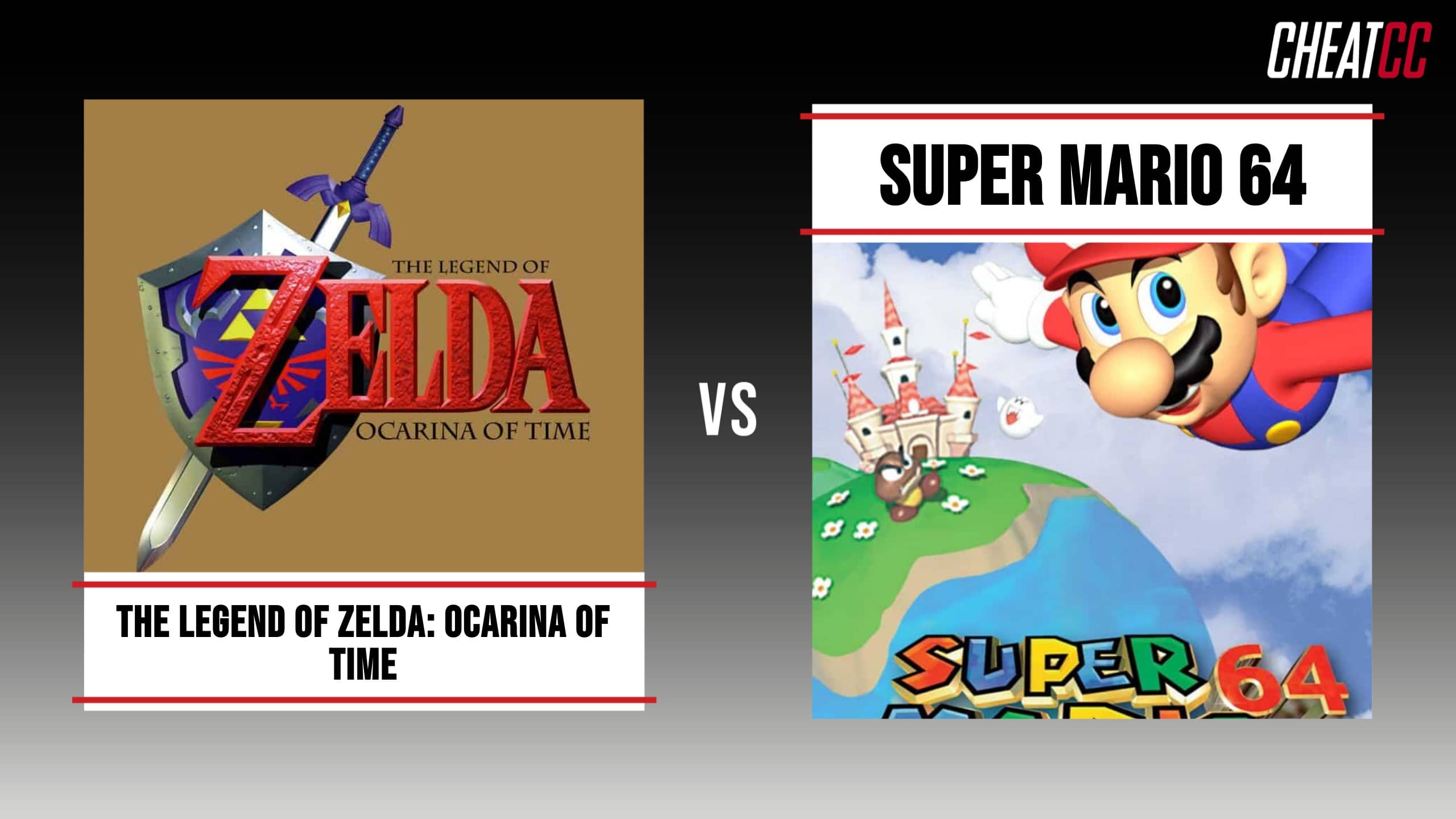The fifth console generation featuring the Sony PlayStation, Sega Saturn, and Nintendo 64 proved to be the battleground for franchises making the transition from 2D to 3D. The technological leap between the SNES and Nintendo 64 is one that doesn’t get talked about enough, especially considering Nintendo’s choice to stick to its guns and move forward with a system using proprietary cartridges in the wake of other hardware manufacturers moving to the increasingly ubiquitous CD-ROM format. As it turns out, Nintendo would have an ace up its sleeve in the debut 3D titles for its first-party franchises, which no two titles exhibit more fully than when pitting The Legend of Zelda: Ocarina of Time vs Super Mario 64.
As two franchises responsible in large part for the resurgence of video games in the West and Nintendo’s dominance during both the third and fourth console generations, it’s hard to find any other series as formative and influential as either The Legend of Zelda or Super Mario Bros. Following several successful 2D entries in both franchises, Nintendo’s first 3D outings of both Mario and Zelda would have a lot to prove in order to meet the bar of quality synonymous with both properties. Somewhat tellingly, the Nintendo 64 would practically live and die by Nintendo’s first-party games, of which Ocarina of Time and Super Mario 64 remain two of the best even into the modern era.
The Legend of Zelda: Ocarina of Time vs Super Mario 64: Side-by-Side Comparison

In terms of games synonymous with the Nintendo 64, there are a handful of titles that will immediately come to mind for most fans. Super Smash Bros., Goldeneye 007, Banjo Kazooie, and of course, The Legend of Zelda: Ocarina of Time and Super Mario 64. In terms of their eventual influence on their genres and overall impact on the industry, few games are as historically important as Super Mario 64 or Ocarina of Time, with both titles serving as an early showcase for how to properly translate formerly 2D interactive media into the third dimension. Stepping into the Mushroom Kingdom or Hyrule in 3D for the first time were both revolutionary experiences, and both games act as footnotes in history for how the design of action-adventure games and platrformers would change following their release.
| Characteristic | The Legend of Zelda: Ocarina of Time | Super Mario 64 |
|---|---|---|
| Release Date | November 21, 1998 | June 23, 1996 |
| Launch Title for the Nintendo 64 | ✅ | |
| Total Sales | 7.6 million units | 11.9 million units |
| Review Aggregate Score | 99% | 96% |
| System Pack-In | ✅ | |
| Genre | Action-Adventure | Platformer |
| Ports/Remasters | The Legend of Zelda: Collector’s Edition (GameCube), The Legend of Zelda: Ocarina of Time 3D (Nintendo 3DS) | Super Mario 64 DS (Nintendo DS), Super Mario 3D All-Stars (Nintendo Switch) |
| Legacy | Definitive early open-world 3D adventure, targeting system and exploration would serve as a template for countles other games | First successful 3D platformer, whose design would eventually serve as the template for dozens of successful 3D platformers on 5th and 6th generation consoles |
| Sequel on Nintendo 64 | The Legend of Zelda: Majora’s Mask | N/A |
| Available on Nintendo Switch | ✅ | ✅ |
The Legend of Zelda: Ocarina of Time vs Super Mario 64: 5 Must-Know Facts
Here are 5 must-know facts about The Legend of Zelda: Ocarina of Time and Super Mario 64:
- Both Ocarina of Time and Mario 64 are the first 3D entries in their respective franchises, boldly bringing two of the most important and iconic series of all-time into a brand-new dimension. While Mario 64 arrived in 1996 along with the launch of the system, Ocarina of Time would not release until the end of 1998.
- Both Ocarina of Time and Mario 64 are hugely influential on their respective genres. As the first 3D Zelda game, Ocarina of Time is also technically one of the first fully 3D open-world adventures. Its design and mechanics would impact the Zelda series for over a decade, while Mario and other 3D platformers still continue to use Mario 64‘s design and mechanics as inspiration.
- Both The Legend of Zelda: Ocarina of Time and Super Mario 64 are two of the most-successful games in their respective series. In terms of both critical success, Ocarina of Time is one of the most important games of all-time, holding the highest review aggregate score of any game in history. Meanwhile, Super Mario 64 is far and away the best-selling Nintendo 64 game.
- Much like how The Legend of Zelda and Super Mario Bros. proved to be system-sellers and killer apps for both the NES and SNES, millions of gamers would flock to the Nintendo 64 to experience the first 3D entries in both franchises. Super Mario 64‘s existence as a sytsem pack-in would make it an important piece of the Nintendo 64’s history.
- While Ocarina of Time and Mario 64 are not the first 3D action-adventure games or platformers, they are two of the most critically and commercially successful early 3D games.
The Legend of Zelda: Ocarina of Time vs Super Mario 64: Bringing Nintendo’s Legacy Into 3D
The launch of the PlayStation came during the waning days of the SNES’ lifecycle, prompting many fans to speculate how Nintendo’s franchises would fare in making the transition from 2D to 3D when the company’s next console launched. Super Mario 64 proved to be mind-blowing to players of the era, reimagining the classic Mario gameplay into the third dimension and far surpassing earlier, more primitive attempts at 3D gaming. Similarly, The Legend of Zelda: Ocarina of Time would go on to be just as, if not more, influential than the original Legend of Zelda on action-adventure games and Nintendo’s software development strategy.
The Legend of Zelda: Ocarina of Time vs Super Mario 64: Impact on Genres
In terms of the mammoth influence that both Ocarina of Time and Super Mario 64 have on their genres, it’s important to examine exactly what it is that each game brings to the table during the earlier years of 3D gaming. In terms of The Legend of Zelda: Ocarina of Time, Link’s first 3D adventure introduces the Z-Targeting system that would eventually influence not just the Zelda franchise but all 3D action-adventure games, revolutionizing how camera controls and player perspective should work in an interactive 3D environment. Similarly, Super Mario 64 is still one of the best examples available concerning how fluid 3D movement should feel in a piece of interactive media.
The Legend of Zelda: Ocarina of Time vs Super Mario 64: Sales and Reception
While both The Legend of Zelda: Ocarina of Time and Super Mario 64 are each incredibly commercially and critically successful, it’s interesting to see how one game holds the crown for sales while the other still remains the most positively-reviewed game to this day. Super Mario 64 is the best-selling game on the Nintendo 64, far outselling every other game on the system to eventually amass nearly 12 million units in sales. On the other hand, The Legend of Zelda: Ocarina of Time beats out Super Mario 64‘s 96% critical aggregate score with its 99% average, having the highest critical reception of any game in the history of the medium.
The Legend of Zelda: Ocarina of Time vs Super Mario 64: Cementing the Nintendo 64’s Legacy
The system pack-in is an older gaming tradition that has fallen out of vogue, but during the 5th console generation there were several different bundles available across hardware manufacturers that each would attempt to showcase the definitive software available on the platform. Super Mario 64 is the original pack-in for the Nintendo 64, acting as a proof-of-concept for the system’s 3D capabilities and emphasizing what the console would bring to the table more than its competitors. While Ocarina of Time would never be a system pack-in, it is one of the many titles that would help position the Nintendo 64 as an important pillar of the industry in spite of PlayStation’s dominance in the 5th console generation.
Bottom Line
Honestly, it’s safe to assume that most players who owned a Nintendo 64 had a copy of both Ocarina of Time and Mario 64 in their game libraries. Nintendo’s first-party games were so central to the N64’s success and were continually a showcase for the best innovation and design on the system, so trying to determine whether it’s Zelda or Mario that is more important to a particular console generation typically has to come down to a numbers game, comparing the sales and critical reception of each title for a definitive winner based on quantitative data. Unfortunately, both Ocarina of Time and Mario 64 each have contrasting successes that make calling a definitive winner difficult still in the face of pure numerical information.
Yes, Super Mario 64 is the best-selling game on the console and an incredible 3D platformer that still influences the genre to this day. The same can be said about Ocarina of Time, which is both one of the best Zelda games of all-time and one of the most important innovations and leaps forward in 3D gaming. Declaring a “definitive” game for the Nintendo 64 isnt’ easy, but it ultimately falls to The Legend of Zelda: Ocarina of Time for the way that it transcends its own series and IP to be one of the most groundbreaking early 3D experiences. Thanks to its historic importance and peerless critical reception, Ocarina of Time is the Nintendo 64’s definitive game.
